
We are the Slow Farming Company, a fifth generation farming family outside Castle Cary in South Somerset. The farm is run by my stepfather Rob and mother Sally, and I work here part time along with my wife Camilla – our three young children like to get involved too! We are on a regenerative journey with the aim of creating nutrient rich food from diverse cropping, with the added benefit of carbon capture. The farm is on medium to heavy clay, and runs to approximately 160 acres.
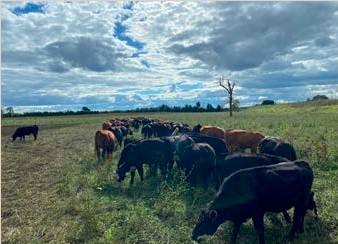
We have a herd of 180 head of beef cattle, running an Aberdeen Angus bull on mainly Hereford cross British Friesian cows with a few Limosian and Belgian blue crosses for good measure. Our oldest cow is 16 years old and still producing a calf a year. We deliberately moved over to a spring calving regime in 2017 to take advantage of the spring grass and milder weather.
Our move into regenerative farming has been gradual, over the last seven years or so. We reduced and then dropped artificial fertilizer on our pasture ground five years ago, and ceased the pure arable rotation four years ago. We were driven to do this by the lack of life in our soil and the loss in wildlife in our fields.
We were spurred on by Tim, a neighbouring farmer, who introduced us to the likes of Gabe Brown and Joel Salatin. Between Rob and me many hours of YouTube talks were consumed. Regenerative farming was probably the most talked about subject around our kitchen tables between 2013 and 2016 – also the period in which our two of our three children were born and we obtained planning permission to convert a traditional barn into a home for our family. We were lucky enough to hear a talk by Joel at Bristol University in 2016 and for us both it was a bit of an epiphany moment.
If he could do it in America, why couldn’t we do it here?
A couple of years before, Rob had ploughed up two small fields and planted a herbal ley mix undersown with spring barley. When we cut off the barley for wholecrop, the herbal ley carried on with gusto. Following on from those initial trial plots, we Min Tilled 30 acres of former arable land and seeded in the crop with a Wox GreenMaster. Later that year we were mob grazing through the herbal ley with Chicory at up to ten foot tall. Driving the buggy through it to set the fences was a particular skill. The cattle did very well on it and showed good growth rates. In 2016 we stopped adding any cereal to the diet, although we had only been feeding the equivalent of a pound a head. We wanted to move to a pure grass fed diet, not least for the emerging nutritional benefits of 100% pasture fed beef, but we also just felt it was the right thing to do.
Alongside the beef, in July 2017 we converted a mobile home into a pastured egg-mobile with 300 laying hens. These eggs were initially sold through a local pack house, under the brand Birds and Herds. The hens followed the cows scratching through and spreading the dung, as well as producing their own source of nitrogen. Unfortunately, this partnership came to an end when the packer went into administration. We had a hectic six weeks of building a packing room, getting an egg packing licence and finding customers for all the eggs. However now, most weeks, we have more customers than we have eggs.
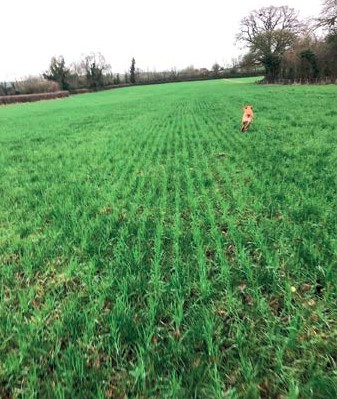
In 2017 we took the decision not to use the plough on the farm again. Again, this was a course of action that just made sense to us. We were looking to build our soil and prevent erosion, not least because on our clay soils we’re at risk of significant poaching. Since then we have changed to Min Til to terminate grass in the spring prior to sowing or direct drilling.
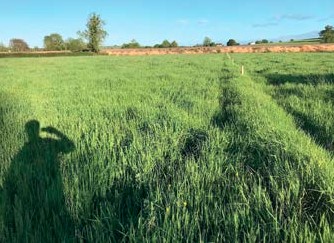
In 2018 we carried out several experiments, direct drilling a mix of oats, beans and vetch straight into permanent grassland after the last grazing in the autumn. By this time, the grass has gone into senescence and so doesn’t compete against the winter sown cereals. We both grazed and silaged this successfully. This year we did 25 acres of oats and vetch for grazing.
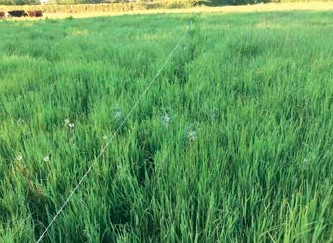
In spring 2019 we entered the Mid-Tier scheme, as well as going into organic conversion via Organic Farmers and Growers. We have planted five hectares of wild bird seed mix and Bumble Bird mix. We have seen a big boost in the number of birds on the farm as a result, including a big group of gold finches that seem to hang around all year. We have planted an additional 30 acres of herbal ley that fits in well to our mob grazing rotation, providing high quality food for finishing the cattle. The fact that the herbal leys are almost always in a stage of flowering has led to a tie up with a local honey company to put their hives here, which we’re really excited about.
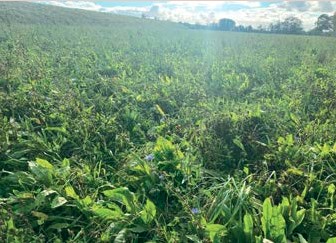
Organic conversion led us to even greater consideration of our soil and what we are doing with it. Rob got caught in a tremendous rain storm one afternoon when moving the cattle fences. He was amazed to see that, whilst the rain initially travelled across the ground, as soon as it stopped raining the water disappeared into the soil, not sitting on the surface. When I moved the fences that weekend, you wouldn’t have realised we had had been one and a half inches in an hour. Our manure handling has also taken a turn, quite literally. We now empty the sheds in the spring into windrows in the fields, where we turn it with the telehandler to encourage composting. The volume that we then get to spread is much reduced, but is readily available to the plant. It also means fewer wheelings on the field, as spread rates are down to approx 2 tons per acre.
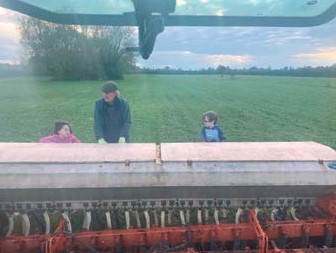
Alongside our Pasture for Life, Red Tractor and Organic certification we also wanted to find a marque that would reflect the regenerative aspect of the way that we farm. On our local Regen Ag WhatsApp group, the Greener World Regenerative certified pilot scheme came up. We were lucky to be accepted at the beginning of the year, and are well on the way to finishing drawing up our 5 year plan for improvements to farm operations, biodiversity and the general environment in which we live. In conjunction with this we are also working towards certification for Grass Fed Beef, Non GMO Eggs and High Animal Welfare as part of the Greener World system.
We have big plans for 2021/22 – we are clearing out old ponds on the farm and looking to replace some of our mob grazing paddock fences with new hedgerows and fruit trees in some fields. Along with hopefully moving in to our barn conversion!
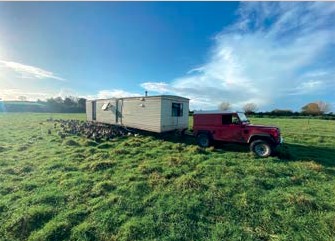
We look forward to sharing this journey with you.